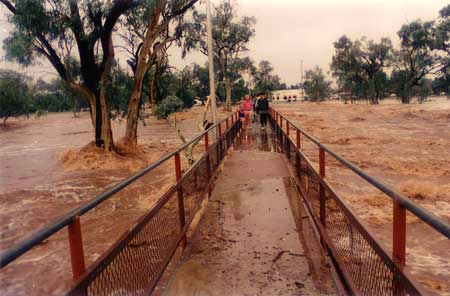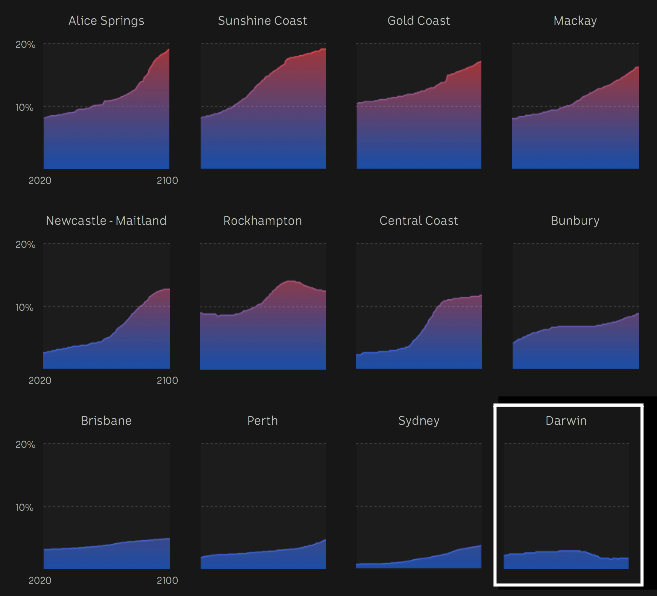Climate change: Home insurance shock
27 October 2019
 By ERWIN CHLANDA
By ERWIN CHLANDA
Alice Springs landed in top spot in a comprehensive survey of home insurance costs driven by climate change.
Except it’s not an achievement. It’s the opposite: We have the almost highest percentage of “uninsurability” right now and by the end of the century we’ll be No 1, according to the report.
The analysis, by leading climate risk analyst Karl Mallon, supplied exclusively to ABC News, calculates how changing climate risks (such as bushfire, flood, subsidence, inundation and extreme wind) would impact the cost and availability of insurance up to the year 2100 if all such risks were insured.
The irony is that the 11 top-ranking addresses are seaside cities, except Rockhampton, which is straddling the Fitzroy River.
But Alice Springs is 600 metres above sea level: The flood risk here therefore is exclusively from the Todd River, and it is absolutely within our engineering powers to stop or hugely mitigate that risk.
So if more and more Alice Springs people will become unable to insure their homes, the blame will rest with the NT Government and the Town Council because of their sustained failure to build flood mitigation.
“Riverine flooding can cause significant damage,” says the report. “Like inundation it has a strong impact on uninsurability.”
Dr Mallon says insurance premiums in Alice Springs between 2020 and 2100 will more than double. 11.5% or 76 of 662 addresses will be potentially uninsurable by 2050. This will rise to 18.9% — or 125 addresses — by 2100.
At 9am on October 24 the News sought comment from MLA Braitling Dale Wakefield, the Town Council and the Chamber of Commerce. None replied.
Image from the report: ‘Uninsurability’ in selected cities with over 10,000 addresses. Ranked from highest to lowest percentage of ‘uninsurable’ addresses in 2100. The Darwin numbers are much lower than the Alice Springs ones.




A class action against the NT Government for inaction on reports may occur?
From memory this is the same report that was described as “news to me” by the president of ( I think) the insurance association of Australia?
Sorry, I can’t remember where I read the reply to this when it was originally posted.
Either way the opportunity to develop the Todd River and in turn, manage the flood risk has been sadly wasted for many years.
The bike track from behind St Philips to the Telegraph Station is what the Todd River should look like.
The overgrown, tangled and clogged mess that occurs between Schwartz Crescent and out past Old Timers is a result of our occupation of this town since the beginning, and our influence destroying its natural beauty.
The fact that introduced grasses have taken hold through this tract is the obvious result of our love of a green lawn in the desert, and even I love my green lawn, but we have not dealt with the inadvertent impact of it.
This is what has encouraged the build-up of unnatural islands, and the redirection of the river’s course, not to mention the raising of the bed and clogging of the “artery” that runs through our town.
We must be one of the few towns where a river that runs through town is not managed and maintained as an integral part of the life of the town and the focus of activity.
The AAPA identified sacred trees as part of the Alice in Ten project in the early 2000s.
There were very few that needed to be kept as culturally significant, many many of the newer trees would hold no cultural significance, and should be removed as they would not have grown there but for our influence.
The same mapping should occur in the stretch I mentioned earlier. It needs to be cleaned out, the banks redefined and reinforced and shaped with caged rocks like along Railway Terrace.
The bank could be raised and levelled and beautified to become a central point.
The lawned area outside the Todd Tavern is beautiful, the river there is an eyesore and a disgrace.
For anybody who says we should not mess with nature, the opposite seems true.
The river has been left in ruin due to our activities.
We need the council to step up with the government, and give serious thought to bring it back to its former glory, as a centrepiece of our town, by clearing and restoring.
Water capture could be done for long term irrigation of the banks using green technology, and the other possibilities are boundless.